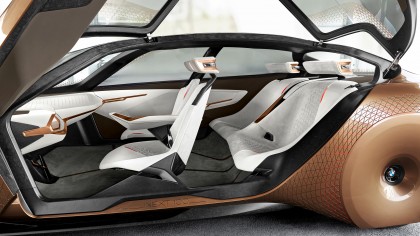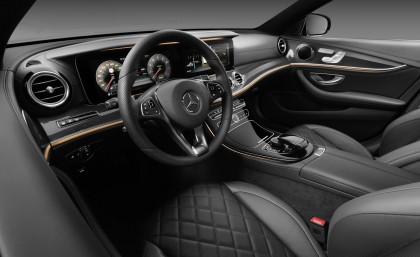The future of driving: a look at the car of 2026
Next decade's cars are smarter, safer and increasingly connected

Ten years of development will usually see some pretty big changes in any product field – but in the car world, a decade is a veritable eternity.
So what, exactly, will cars look like by 2026? Will Google, Tesla or somebody else have pulled off the fully autonomous car? Will you still be filling up at the pumps? And if you are, will it still be with petrol and diesel?
What technologies will it sport inside? Are we talking head-up displays and augmented reality, or full Vulcan mind meld stuff?
We've spoken to some of the world's biggest car manufacturers to find out what they think will be in store – and on the roads – 10 years from now.
The autonomous car
It's the biggest question of all: will cars be fully autonomous by 2026? The simple answer is it's unlikely...but not necessarily because of technological limitations. Legislation and even public sentiment (think killer robocar stories in tabloid newspapers), along with issues such as insurance liability (who's responsible when an autonomous car crashes?) are just as critical.
However, it's worth pondering the extent to which cars are already autonomous in certain situations. Take the latest BMW 7 Series automobile: according to Andrew Furse, tech guru at BMW UK headquarters, it's capable of self-steering on the autobahn and staying centred in a lane at speeds up to 130mph. You can even take your hands off the wheel for up to 15 seconds, local laws allowing.

Tesla offers similar functionality, albeit not at quite the same autobahn-busting speeds. But what about in 2026? Furse reckons 'hands off' technology will be more widely available, and in scenarios beyond just lane-keeping on motorways.
Sign up for breaking news, reviews, opinion, top tech deals, and more.
And cars will be capable of some additional clever moves. "Automated overtaking, using the indicator to request an overtake carried out by the car, is likely by 2026," Furse says.
As for the ultimate goal of fully hands-off automated driving by 2026, Furse thinks that may be possible in certain circumstances – you may be able to make a video call, browse the internet or compose emails for a short period. But you won't be able to jump into a BMW in 2026 and have it autonomously drive you door-to-door.
What's more, the simple act of enjoying driving will still be a core feature, even as autonomous functionality broadens. "The ability to drive yourself, to have fun, will remain core to BMW," promises Furse.
In-car tech and connectivity

For Mercedes, the vision for 2026 in terms of in-car tech is that it'll actually be quite difficult to define where in-car tech starts and finishes, thanks to connected cars that are synced with your online profiles, calendars and social networks.
"You can imagine stepping into your car in 2026, it already knows where you are going, the navigation system is primed and ready to route you," explains Georges Massing, Mercedes' user interaction expert.
"Even before you get into the car, you'll be connected via a smartphone app. It might suggest that skipping breakfast will help avoid traffic, or indicate that due to road congestion, splitting the journey with public transport will get you to your destination more quickly."

"On your way back, your car will be able to pre-heat your house and switch on the lights as your pull into the drive," Massing adds. Put simply, your car will be fully integrated into your digital life.
Increased connectivity and the ability to hook into a central, brand-agnostic, database will also make cars more aware of their surroundings and environment. "Let's say you have an accident. In future the car will be able to communicate that to Mercedes' back-end systems, and that information will in turn be transmitted to other cars within seconds," says Massing.
Add further information shared between cars, including weather, road surface conditions, traffic and details like lane closures on motorways, and you'll have vehicles with an almost spooky ability to know what's in the road ahead long before you or the car's sensors do.
Displays and interfaces
Nothing dates a car these days like its multimedia display. Screens and interfaces from just five years ago look ancient – and by 2026 we'll likely see even more dramatic changes.
BMW's Furse points out that the company's cars already support gesture controls, and this will be taken to new levels. Imagine a context-aware car that knows what you want almost before you do: reach your hand towards a door, for instance, and the car will know you want to open the door and gently swing it towards you.

Furse points out that BMW had head-up displays, or HUDs, in cars 12 years ago. By 2026 he thinks it likely that BMW HUDs may be capable of picking out pedestrians and other hazards, and highlighting them on the windscreen via some fairly radical augmented reality tech.
That could apply to blind spots in the car – the entire interior of the car could be an augmented display, with parts of the dash or cabin wall changing colour or shape to indicate hazards, meaning an end to over-the-shoulder and windscreen-pillar blind spots.

Mercedes has a similar HUD-centric view of the future of car displays. Massing says it's all about intelligently presenting information to the driver. "People are used to being connected all the time," he says.
The problem is that all that information can be distracting to the driver. Already, the latest Mercedes E-Class includes an advanced HUD with mouse-like controls on the steering wheel to help drivers keep their eyes on the road. By 2026, cars will be expert in giving the driver the right information at the right time.
Engines and fuel
If it's a surefire bet that the car of 2026 will be more automated and more connected than ever, the source of its energy is a much more open question.
BMW's Furse says the future won't be 'one size fits all', like the age of combustion cars. Already BMW offers a range of pure combustion, hybrid and pure electric cars; the BMW i3 is available in both pure-electric and hybrid variants.
"The general trend will be towards more electrification," Furse reckons, including electric cars with longer operating ranges, although combustion technology will still be a big part of the market in 2026.
Already Tesla offers electric cars with ranges in excess of 300 miles, and by 2026 the first electric car to bust the 500-mile barrier (and offering much faster charging) should have been on sale for a while. As for hydrogen power, "that will likely be a slow burn due to the need for new infrastructure", says Furse.
The car in 2026
So that's a picture of the car in 2026. It'll know where you're going even before you climb in. It'll be able to drive you part of (but not all) the way. It'll keep you connected and safe en route, helping you avoid both traffic in general and individual hazards in the road ahead, as well as enabling you to safely interact with various online media while on the move.
And it will feed information to you via advanced augmented-reality, head-up and smart displays that will blur the boundaries between the cabin and the screen.
Oh, and there's a good chance it'll be at least partially powered by electricity too.
Comfort, safety and intelligence will be on offer in even the most rudimentary of cars by the time we're a quarter of the way through this century.
Technology and cars. Increasingly the twain shall meet. Which is handy, because Jeremy (Twitter) is addicted to both. Long-time tech journalist, former editor of iCar magazine and incumbent car guru for T3 magazine, Jeremy reckons in-car technology is about to go thermonuclear. No, not exploding cars. That would be silly. And dangerous. But rather an explosive period of unprecedented innovation. Enjoy the ride.